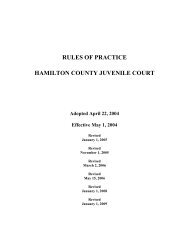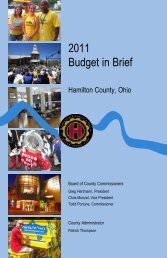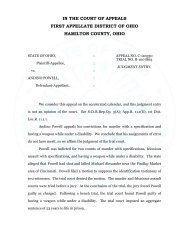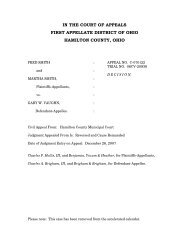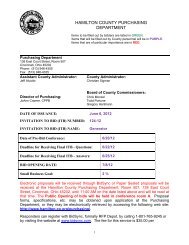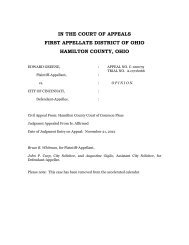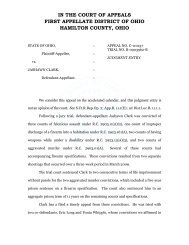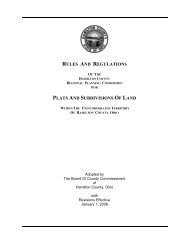Planning in The Age of Sprawl - Hamilton County, Ohio
Planning in The Age of Sprawl - Hamilton County, Ohio
Planning in The Age of Sprawl - Hamilton County, Ohio
Create successful ePaper yourself
Turn your PDF publications into a flip-book with our unique Google optimized e-Paper software.
“We must elim<strong>in</strong>ate the two pr<strong>in</strong>cipal causes <strong>of</strong> sprawl: artificially cheap land and artificially<br />
cheap energy”, advises Douglas Kelbaugh <strong>in</strong> Common Place -- Toward Neighborhood and<br />
Regional Design. “<strong>The</strong> two most far-reach<strong>in</strong>g corrections would be to make gasol<strong>in</strong>e and<br />
rural land more expensive, so that their market prices more closely reflect their true cost.<br />
<strong>The</strong> capital costs <strong>of</strong> sprawl are high: new highways, roads, sewers, utilities, water systems;<br />
new schools and school bus fleets; new stores and jobs that require the private transit <strong>of</strong><br />
automobiles with the attendant air pollution, congestion and lost time. Yet, we cont<strong>in</strong>ue to<br />
develop the urban fr<strong>in</strong>ge despite the high costs <strong>of</strong> improvement. Why Because it's so<br />
pr<strong>of</strong>itable. <strong>The</strong> capital cost <strong>of</strong> land is still cheap and the burden <strong>of</strong> <strong>in</strong>frastructure can <strong>of</strong>ten<br />
still be shifted to the public sector. Subsidized energy (for transportation and hous<strong>in</strong>g)<br />
masks the high operat<strong>in</strong>g costs <strong>of</strong> suburbia.” He rem<strong>in</strong>ds us that legislative lobbyists<br />
certa<strong>in</strong>ly know their bread is buttered on the suburban more than the urban side.<br />
<strong>The</strong> European experience provides greater clarification <strong>of</strong> the complexity <strong>of</strong> “smart<br />
growth” (i.e., compact growth without sprawl) and its unlikely fit <strong>in</strong> our American culture.<br />
Pietro Nivola, <strong>in</strong> Fit for Fat City: A “Lite” Menu <strong>of</strong> European Policies to Improve Our<br />
Urban Form, identifies key policies that have pr<strong>of</strong>oundly slowed suburban spread <strong>in</strong><br />
European cities. He dispels the conventional wisdom that European land use laws and<br />
central plann<strong>in</strong>g agencies are stronger than <strong>in</strong> the US. Instead, Nivola po<strong>in</strong>ts to several key<br />
policies that have conta<strong>in</strong>ed European sprawl:<br />
• Large agricultural subsidies make it less likely that farmers will sell their land to<br />
developers.<br />
• Heavy taxation <strong>of</strong> gasol<strong>in</strong>e and high rates for electric power and furnace fuels make it<br />
much more expensive to live an American-style suburban life, with a large home,<br />
multiple vehicles, a long commute, and the gigantic refrigerator and freezers that make<br />
occasional shopp<strong>in</strong>g possible.<br />
• <strong>The</strong> tax systems <strong>of</strong> most European countries make cars much more expensive and don’t<br />
subsidize home ownership.<br />
• Small neighborhood shops are protected by multiple restrictions on the penetration and<br />
pric<strong>in</strong>g practices <strong>of</strong> large retailers.<br />
• Post-war build<strong>in</strong>g and rebuild<strong>in</strong>g focused on mixed-<strong>in</strong>come apartments, while the U.S.<br />
encouraged home build<strong>in</strong>g with Federal Hous<strong>in</strong>g Adm<strong>in</strong>istration and Veterans<br />
Adm<strong>in</strong>istration mortgage guarantees.<br />
• Transportation spend<strong>in</strong>g <strong>in</strong> the post-war period was roughly balanced between passenger<br />
railroads and highways, while <strong>in</strong> the U.S. spend<strong>in</strong>g on highways dwarfed spend<strong>in</strong>g on<br />
alternatives by almost 6 to 1 <strong>in</strong> the same period.<br />
In contrast to the European experience, the American smart growth ideology seems<br />
simplistic. <strong>The</strong> magnitude <strong>of</strong> the required cultural “paradigm shift” is enormous. In <strong>The</strong><br />
Ecology <strong>of</strong> Place: <strong>Plann<strong>in</strong>g</strong> for Environment, Economy and Community, Timothy Beatley<br />
identifies the cult <strong>of</strong> <strong>in</strong>dividualism that has so eroded community values <strong>in</strong> the U.S. For<br />
example, consider the follow<strong>in</strong>g excerpt. “Material use, energy consumption and<br />
environmental degradation <strong>in</strong> the <strong>in</strong>dustrial world will have to be reduced by 90% to achieve<br />
global socioeconomic susta<strong>in</strong>ability. Yet material and energy consumption is still <strong>in</strong>creas<strong>in</strong>g<br />
HCRPC<br />
PLANNING IN THE AGE OF SPRAWL<br />
9



